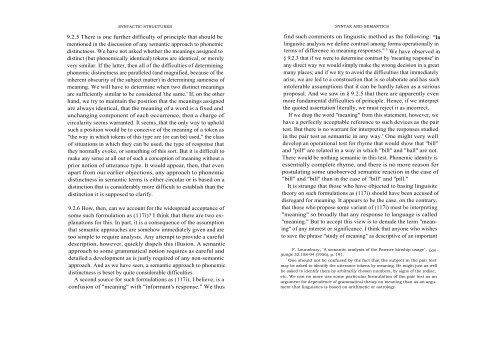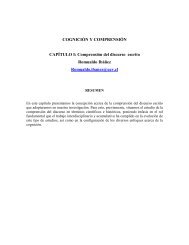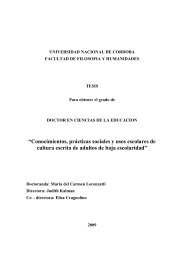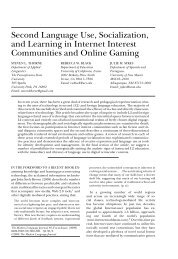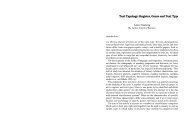Syntactic Structures
Syntactic Structures
Syntactic Structures
Create successful ePaper yourself
Turn your PDF publications into a flip-book with our unique Google optimized e-Paper software.
SYNTACTIC STRUCTURES<br />
9.2.5 There is one further difficulty of principle that should be<br />
mentioned in the discussion of any semantic approach to phonemic<br />
distinctness. We have not asked whether the meanings assigned to<br />
distinct (but phonemically identical) tokens are identical, or merely<br />
very similar. If the latter, then all of the difficulties of determining<br />
phonemic distinctness are paralleled (and magnified, because of the<br />
inherent obscurity of the subject matter) in determining sameness of<br />
meaning. We will have to determine when two distinct meanings<br />
are sufficiently similar to be considered 'the same.' If, on the other<br />
hand, we try to maintain the position that the meanings assigned<br />
are always identical, that the meaning of a word is a fixed and<br />
unchanging component of each occurrence, then a charge of<br />
circularity seems warranted. It seems_that the only way to uphold<br />
such a position would be to conceive of the meaning of a token as<br />
"the way in which tokens of this type are (or can be) used," the class<br />
of situations in which they can be used, the type of response that<br />
they normally evoke, or something of this sort. But it is difficult to<br />
make any sense at all out of such a conception of meaning without a<br />
prior notion of utterance type. It would appear, then, that even<br />
apart from our earlier objections, any approach to phonemic<br />
distinctness in semantic terms is either circular or is based on a<br />
distinction that is considerably more difficult to establish than the<br />
distinction it is supposed to clarify.<br />
9.2.6 How, then, can we account for the widespread acceptance of<br />
some such formulation as (117i)? I think that there are two explanations<br />
for this. In part, it is a consequence of the assumption<br />
that semantic approaches are somehow immediately given and are<br />
too simple to require analysis. Any attempt to provide a careful<br />
description, however, quickly dispels this illusion. A semantic<br />
approach to some grammatical notion requires as careful and<br />
detailed a development as is justly required of any non-semantic<br />
approach. And as we have seen, a semantic approach to phonemic<br />
distinctness is beset by quite considerable difficulties.<br />
A second source for such formulations as (117i), I believe, is a<br />
confusion of "meaning" with "informant's response." We thus<br />
SYNTAX AND SEMANTICS<br />
find such comments on linguistic method as the following: "In<br />
linguistic analysis we define contrast among forms operationally in<br />
terms of difference in meaning responses." 6 We have observed in<br />
§ 9.2.3 that if we were to determine contrast by 'meaning response' in<br />
any direct way we would simply make the wrong decision in a great<br />
many places; and if we try to avoid the difficulties that immediately<br />
arise, we are led to a construction that is so elaborate and has such<br />
intolerable assumptions that it can be hardly taken as a serious<br />
proposal. And we saw in § 9.2.5 that there are apparently even<br />
more fundamental difficulties of principle. Hence, if we interpret<br />
the quoted assertation literally, we must reject it as incorrect.<br />
If we drop the word "meaning" from this statement, however, we<br />
have a perfectly acceptable reference to such devices as the pair<br />
test. But there is no warrant for interpreting the responses studied<br />
in the pair test as semantic in any way.' One might very well<br />
develop an operational test for rhyme that would show that "bill"<br />
and "pill" are related in a way in which "bill" and "ball" are not.<br />
There would be nothing semantic in this test. Phonemic identity is<br />
essentially complete rhyme, and there is no more reason for<br />
postulating some unobserved semantic reaction in the case of<br />
"bill" and "bill" than in the case of "bill" and "pill."<br />
It is strange that those who have objected to basing linguisitc<br />
theory on such formulations as (117i) should have been accused of<br />
disregard for meaning. It appears to be the case, on the contrary,<br />
that those who propose some variant of (117i) must be interpreting<br />
"meaning" so broadly that any response to language is called<br />
"meaning." But to accept this view is to denude the term "meaning"<br />
of any interest or significance. I think that anyone who wishes<br />
to save the phrase "study of meaning" as descriptive of an important<br />
F. Lounsbury, "A semantic analysis of the Pawnee kinship usage", Language<br />
32.158-94 (1956), p. 191.<br />
' One should not be confused by the fact that the subject in the pair test<br />
may be asked to identify the utterance tokens by meaning. He might just as well<br />
be asked to identify them by arbitrarily chosen numbers, by signs of the zodiac,<br />
etc. We can no more use some particular formulation of the pair test as an<br />
argument for dependence of grammatical theory on meaning than as an argument<br />
that linguistics is based on arithmetic or astrology.


